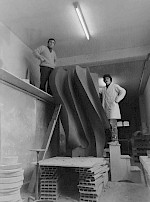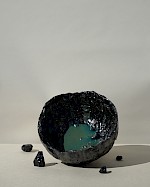Carlo Zauli was born in Faenza on 19 August 1926. From an early age he showed great manual aptitude, which led him to enrol at the “Regio” Art Institute for Ceramics in Faenza, later named in memory of “Gaetano Ballardini”, where he attended the technological studies course. Zauli’s education was interrupted in 1944, when he was deported to Germany to the Hülz labour camp. He did not return to school until two years later, becoming a pupil and collaborator of Angelo Biancini: Zauli obtained his ‘Technical Studies’ diploma in 1948 and, the following year, completed his studies with a ‘Special Course in Ceramic Decoration’.
The sculptor’s long artistic career began in 1950 when, together with his friends Umberto Zannoni, Averardo Giovannini and Renato Zama, he took over the studio of ceramist Mario Morelli, Nuova Cà Pirota, located in Via della Croce in Faenza. After winning the main awards dedicated to ceramic art, the early 1960s saw him evolve towards a markedly sculptural interpretation of his craft. In these years he matured his own artistic language, imbued with informal atmospheres intertwined with a harmonious yet disruptive ‘naturalness’: these were the years of his growing international success.
Since 1958, the year in which the large high-reliefs for the palace in Baghdad and the Kuwait State Printing House were realised, he has seen his fame grow steadily until, in the 1970s and 1980s, he travelled all over Europe, Japan and North America, where he held exhibitions and permanently placed works. His works can now be found in forty museums and public collections all over the world.
After his death in 2002, the Carlo Zauli Museum, directed by his son Matteo Zauli, was inaugurated in the same location as his atelier.


